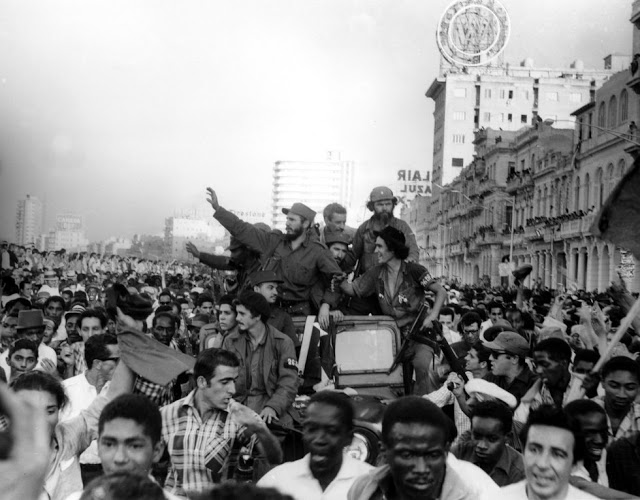
It is above all history and at the same time legend: on January 8, 1959, the Caravan of Freedom arrived in Havana headed by Commander in Chief Fidel Castro, at the head of the forces of the Rebel Army and other combat organizations, coming from the East, which had departed from Santiago de Cuba and in a journey of more than a thousand kilometers ratified and celebrated the triumph of the Revolution, proclaimed on the first day of the year.
The young leader, a lawyer whom many citizens of the city knew as an outstanding student of the Colegio de Belen and an active revolutionary at the University of Havana, whose struggle and leadership had been essential to put an end to the ignominy of the Batista dictatorship, was received with great enthusiasm.
To see and touch with their hands the mythical bearded and even long-haired men of the Sierra Maestra, main protagonists of the heroic deed, provoked an unspeakable enthusiasm, materialized in intimate hugs, shoulder loads, flowers and gestures of hospitality and gratitude, according to witnesses of those events.
What happened in the rest of the cities, towns and roads of the national territory where the historic Caravan of glorious soldiers of the people passed through was reproduced on the great stage of the city.
Among cheers and thanks, there were also songs and tears of joy and feeling in memory of all those who fell on the road to the conquest of justice, freedom and sovereignty.
Accompanied by a crowd that included, among others, some 3,000 guajiros from all over the country, well trained in combat, Fidel entered Havana through the popular neighborhood of Cotorro, where Commander Juan Almeida was waiting for him with his forces. With them he continued advancing to the famous Virgen del Camino.
Near the statue of the Saint, they were joined by Camilo Cienfuegos, who, like Che Guevara, had advanced his entry into Havana on Fidel's orders, both having just shaken off the remains of dust and shrapnel from the famous Battles of Yaguajay and Santa Clara, the culmination of the final offensive from East to West.
It will always be rightly said that on that January 8, Havana people danced, laughed and cried in the streets out of pure emotion and joy, together with their compatriots from the archipelago.
Fidel could not avoid leaving the Caravan momentarily and boarding the Granma yacht, when it appeared tied to a dock during the trip, a surprise prepared by Camilo hours before, since the vessel had been used by the Batista Navy to render service on the Isle of Pines. The commotion for that stop was enormous.
However, the emotions reached a climax in the evening hours before the sharp speech delivered by the leader until the early hours of January 9, at the site of the old Columbia Military Fort, whose walls were demolished by the "Señor de la Vanguardia" to turn it later into Ciudad Escolar Libertad (Liberty School City).
And with his far-sighted thought, in his perennial journey into the future, he said:" Here we are in the capital, here we are in Columbia, the revolutionary forces seem victorious; the government is constituted, recognized by numerous countries of the world, peace has apparently been conquered; and yet we must not be optimistic.
"While the people were laughing today, while the people were rejoicing, we were worried; and the more extraordinary the crowd that came to receive us, and the more extraordinary the joy of the people, the greater our concern, because the greater our responsibility before history and before the people of Cuba".
Earlier, in Santiago, he had resolutely stated that this was going to be the true Cuban Revolution, that of the founding fathers, of Jose Marti and so many genuine heroes and martyrs, without sellouts, opportunists, thieves or sellouts.
In Havana, he warned about how much remained to be done and about the certainty that the hardest part would surely be yet to come.
Cubans have confirmed how right that tireless fighter was and with him they vowed to follow him in the world to come, no matter how difficult and dangerous the road might be.
The people trusted from the beginning. They knew that his promise of change and the world of equity, social justice, freedom and sovereignty for which thousands of their compatriots had died more than once would be true. The green light given to the Revolution in those volcanic and forging days was consolidated in Havana.
Without much delay, the Revolutionary Government undertook the urgent transformations that Cuba needed to create the republic dreamed by Jose Marti, with all and for the good of all.
The General Education Reform that began to fill schools and teachers throughout the national territory with the establishment of free and compulsory education, the Agrarian Reform, access to public health for all, the epic Literacy Campaign, the promotion of art and culture, science and technology, the struggle for women's equality, and economic development programs were processes that followed the entry of the Caravan to Havana.
That and a world of other achievements and advances, in spite of hard and difficult times. Nothing has been fiction, Cuba knows it and that is why it resists, works and advances.
Sidebar

 Agencia Cubana de Noticias
Líder en información nacional
Agencia Cubana de Noticias
Líder en información nacional








Nos reservamos el derecho de no publicar los comentario que incumplan con las normas de este sitio